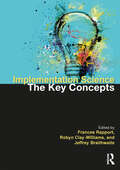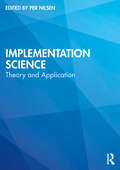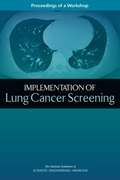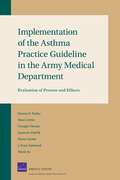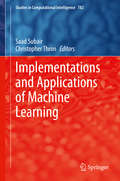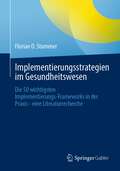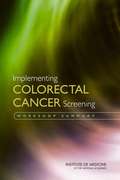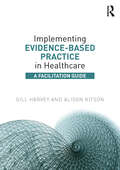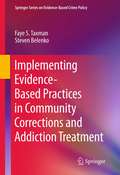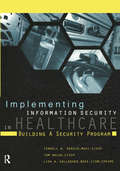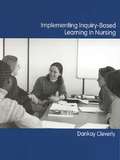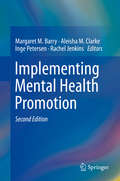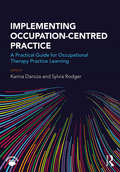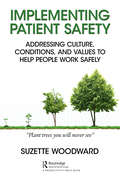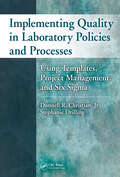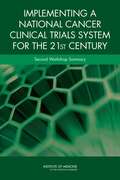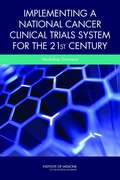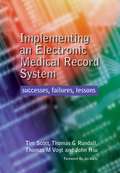- Table View
- List View
Implementation Science: The Key Concepts (Routledge Key Guides)
by Jeffrey Braithwaite Frances Rapport Robyn Clay-WilliamsThis accessible textbook introduces a wide spectrum of ideas, approaches, and examples that make up the emerging field of implementation science, including implementation theory, processes and methods, data collection and analysis, brokering interest on the ground, and sustainable implementation. Containing over 60 concise essays, each addressing the thorny problem of how we can make care more evidence-informed, this book looks at how implementation science should be defined, how it can be conducted, and how it is assessed. It offers vital insight into how research findings that are derived from healthcare contexts can help make sense of service delivery and patient encounters. Each entry concentrates on an important concept and examines the idea’s evidence base, root causes and effects, ideas and applications, and methodologies and methods. Revealing a very human side to caregiving, but also tackling its more complex and technological aspects, the contributors draw on real-life healthcare examples to look both at why things go right in introducing a new intervention and at what can go wrong. Implementation Science: The Key Concepts provides a toolbox of rich, contemporary thought from leading international thinkers, clearly and succinctly delivered. This comprehensive and enlightening range of ideas and examples brought together in one place is essential reading for all students, researchers, and practitioners with an interest in translating knowledge into practice in healthcare.
Implementation Science: Theory and Application
by Per NilsenThis core textbook introduces the key concepts, theories, models and frameworks used in implementation science, and supports readers applying them in research projects. The first part of the book focuses on the theory of implementation science, providing a discussion of its emergence from the evidence-based practice movement and its connections to related topics such as innovation research. It includes chapters looking at a wide range of theories, methods and frameworks currently used in implementation science, and a chapter focusing on suitable theories that could be imported from other fields. The first part also addresses strategies and outcomes of implementation and discusses how researchers can build causal pathways adapted to their study. The second part of the book focuses squarely on putting the theory of implementation science to work in practice, with chapters discussing research methods used in the field and how to select the most appropriate approach. This section also features several chapters presenting in-depth case studies of specific applications.This multidisciplinary text is an essential resource for graduate students from a range of healthcare backgrounds taking courses on implementation science, as well as researchers from medicine, nursing, public health, allied health, economics, political science, sociology and engineering.
Implementation of Lung Cancer Screening: Proceedings of a Workshop
by Engineering Medicine National Academies of SciencesThe public health burden from lung cancer is substantial: it is the second most commonly diagnosed cancer and the leading cause of cancer-related deaths in the United States. Given the individual and population health burden of lung cancer, especially when it is diagnosed at later stages, there has been a push to develop and implement screening strategies for early detection. However, many factors need to be considered for broad implementation of lung cancer screening in clinical practice. Effective implementation will entail understanding the balance of potential benefits and harms of lung cancer screening, defining and reaching eligible populations, addressing health disparities, and many more considerations. In recognition of the substantial challenges to developing effective lung cancer screening programs in clinical practice, the National Academies of Sciences, Engineering, and Medicine held a workshop in June 2016. At the workshop, experts described the current evidence base for lung cancer screening, the current challenges of implementation, and opportunities to overcome them. Workshop participants also explored capacity and access issues; best practices for screening programs; assessment of patient outcomes, quality, and value in lung cancer screening; and research needs that could improve implementation efforts. This publication summarizes the presentations and discussions from the workshop.
Implementation of the Asthma Practice Guideline in the Army Medical Department
by Georges Vernez Donna O. Farley Suzanne Pieklik Elaine Quiter Shan CretinIn partnership with the Army Medical Department, RAND worked to implement clinical practice guidelines. This report evaluates the asthma guideline demonstration. It documents the actions, assesses effects, and measures the quality and limitations of data for monitoring outcomes. The authors found that the implementation scored successes but resource limitations and organizational barriers curbed progress. They conclude that flexibility, monitoring, and training are the keys to implementing the guidelines. They also found that patient education needed improvement.
Implementations and Applications of Machine Learning (Studies in Computational Intelligence #782)
by Saad Subair Christopher ThronThis book provides step-by-step explanations of successful implementations and practical applications of machine learning. The book’s GitHub page contains software codes to assist readers in adapting materials and methods for their own use. A wide variety of applications are discussed, including wireless mesh network and power systems optimization; computer vision; image and facial recognition; protein prediction; data mining; and data discovery. Numerous state-of-the-art machine learning techniques are employed (with detailed explanations), including biologically-inspired optimization (genetic and other evolutionary algorithms, swarm intelligence); Viola Jones face detection; Gaussian mixture modeling; support vector machines; deep convolutional neural networks with performance enhancement techniques (including network design, learning rate optimization, data augmentation, transfer learning); spiking neural networks and timing dependent plasticity; frequent itemset mining; binary classification; and dynamic programming. This book provides valuable information on effective, cutting-edge techniques, and approaches for students, researchers, practitioners, and teachers in the field of machine learning.
Implementierungsstrategien im Gesundheitswesen: Die 50 wichtigsten Implementierungs-Frameworks in der Praxis - eine Literaturrecherche
by Florian O. StummerDie Herausforderungen des 21. Jahrhunderts für das Gesundheitswesen verlangen nach neuen und innovativen Lösungen. Meist ist jedoch die Implementierung eben dieser neuen Prozesse die größte Herausforderung für Unternehmen und Gesundheitseinrichtungen. Sei es die Einführung einer neuen Technologie oder die Etablierung eines neuen Departments - nachweislich scheitern etwa 70 Prozent aller Projekte innerhalb von 36 Monaten. In einer immer schneller werdenden, transdisziplinären Wirtschaftswelt ist es von entscheidender Bedeutung, über die richtigen Implementierungs-Instrumente zu verfügen, um langfristige strategische Veränderungen nachhaltig umsetzen zu können.Das vorliegende Kompendium gibt Ihnen die wichtigsten Implementierungs-Frameworks an die Hand, um auf die Fragestellungen ihrer Organisation effiziente Lösungsprozesse für die Zukunft entwickeln zu können. Die Auswahl erfolgte auf Basis einer wissenschaftlichen Literaturrecherche. Mit zahlreichen Best-Practice-Beispielen aus der Gesundheitsbranche.
Implementing COLORECTAL CANCER Screening: WORKSHOP SUMMARY
by Institute of Medicine of the National AcademiesThe IOM's National Cancer Policy Board estimated in 2003 that even modest efforts to implement known tactics for cancer prevention and early detection could result in up to a 29 percent drop in cancer deaths in about 20 years. The IOM's National Cancer Policy Forum, which succeeded the Board after it was disbanded in 2005, continued the Board's work to outline ways to increase screening in the U.S. On February 25 and 26, 2008, the Forum convened a workshop to discuss screening for colorectal cancer. Colorectal cancer screening remains low, despite strong evidence that screening prevents deaths. With the aim to make recommended colorectal cancer screening more widespread, the workshop discussed steps to be taken at the clinic, community, and health system levels. Workshop speakers, representing a broad spectrum of leaders in the field, identified major barriers to increased screening and described strategies to overcome these obstacles. This workshop summary highlights the information presented, as well as the subsequent discussion about actions needed to increase colorectal screening and, ultimately, to prevent more colorectal cancer deaths.
Implementing Cancer Survivorship Care Planning: Workshop Summary
by Institute of Medicine of the National AcademiesOne of the key recommendations of the joint IOM and NRC book, From Cancer Patient to Cancer Survivor: Lost in Transition, is that patients completing their primary treatment for cancer be given a summary of their treatment and a comprehensive plan for follow-up. This book answers practical questions about how this "Survivorship Care Plan," including what exactly it should contain, who will be responsible for creating and discussing it, implementation strategies, and anticipated barriers and challenges.
Implementing Evidence-Based Practice in Healthcare: A Facilitation Guide
by Gill Harvey Alison KitsonThe successful implementation of evidence into practice is dependent on aligning the available evidence to the particular context through the active ingredient of facilitation. Designed to support the widely recognised PARIHS framework, which works as a guide to plan, action and evaluate the implementation of evidence into practice, this book provides a very practical ‘how-to’ guide for facilitating the whole process. This text discusses: undertaking an initial diagnosis of the context and reaching a consensus on the evidence to be implemented; how to link the research evidence with clinical and patients’ experience and local information in the form of audit data or patient and staff feedback; the range of diagnostic, consensus building and stakeholder consultation methods that can be helpful; a description of facilitator roles and facilitation methods, tools and techniques; some of theories that underpin the PARIHS framework and how these have been integrated to inform a revised version of PARIHS Including internationally-sourced case study examples to illustrate how the facilitation role and facilitation skills have been applied in a range of different health care settings, this is the ideal text for those interested in leading or facilitating evidence based implementation projects, from the planning stage through to evaluation.
Implementing Evidence-Based Practices in Community Corrections and Addiction Treatment
by Steven Belenko Faye S. TaxmanCommunity corrections programs are emerging as an effective alternative to incarceration for drug-involved offenders, to reduce recidivism and improve public health and public safety. Since evidence-based practice is gaining recognition as a success factor in both community systems and substance abuse treatment, a merger of the two seems logical and desirable. But integrating evidence-based addiction treatment into community corrections is no small feat--costs, personnel decisions, and effective, appropriate interventions are all critical considerations. Featuring the first model of implementation strategies linking these fields, Implementing Evidence-Based Practices in Community Corrections and Addiction Treatment sets out criteria for identifying practices and programs as evidence. The book's detailed blueprint is based on extensive research into organizational factors (e.g., management buy-in) and external forces (e.g., funding, resources) with the most impact on the adoption of evidence-based practices, and implementation issues ranging from skill building to quality control. With this knowledge, organizations can set realistic, attainable goals and achieve treatment outcomes that reflect the evidence base. Included in the coverage: Determining evidence for "what works."Organization change and technology transfer: theory and literature review.The current state of addiction treatment and community corrections.Unique challenges of evidence-based addiction treatment under community supervision.Assessing suitability of evidence-based practice in real-world settings.A conceptual model for implementing evidence-based treatment in community corrections. Implementing Evidence-Based Practices in Community Corrections and Addiction Treatment is a breakthrough volume for graduate- and postgraduate-level researchers in criminology, as well as policymakers and public health researchers.
Implementing Information Security in Healthcare: Building a Security Program (HIMSS Book Series)
by Terrell Herzig Tom WalshImplementing Information Security in Healthcare: Building a Security Program offers a critical and comprehensive look at healthcare security concerns in an era of powerful computer technology, increased mobility, and complex regulations designed to protect personal information. Featuring perspectives from more than two dozen security experts, the book explores the tools and policies healthcare organizations need to build an effective and compliant security program. Topics include information security frameworks, risk analysis, senior management oversight and involvement, regulations, security policy development, access control, network security, encryption, mobile device management, disaster recovery, and more. Information security is a concept that has never been more important to healthcare as it is today. Special features include appendices outlining potential impacts of security objectives, technical security features by regulatory bodies (FISMA, HIPAA, PCI DSS and ISO 27000), common technical security features, and a sample risk rating chart.
Implementing Inquiry-Based Learning in Nursing
by Dankay CleverlyIf you want to introduce Inquiry-Based Learning (IBL) into your curriculum but are not sure how to go about it, this book will set you on the right track. In this text the author shares the experience of leading a project to implement IBL as a whole integrated pre-registration curriculum and provides a blueprint for successful implementation.The practicalities of implementing IBL can be a daunting prospect. Using a wealth of examples, relevant theories, models and research, this book takes the reader through the logistics of every stage of implementation. It provides the necessary theoretical and research perspectives and describes the detail how to manage the project stage by stage, covering planning, implementation, evaluation and change management. In addition, it looks at the operational practicalities and describes eight subprojects: staff development; communication systems; the classroom compass; practice experience; documentation; electronic' library and media resources, as well as reviewing the post implementation situation.Whether you are new to or already familiar with Inquiry-Based Learning or simply need some practical guidelines, this book will provide an indispensable source of reference.
Implementing Mental Health Promotion
by Margaret M. Barry Aleisha M. Clarke Inge Petersen Rachel JenkinsThis book offers a comprehensive overview of current research, policy, and practice developments in promoting mental health and well-being. It offers guidance on developing and delivering mental health promotion interventions across a variety of settings internationally. Chapters outline key mental health promotion concepts, implementation processes, and outcomes through empirical findings, practical advice based on successful evidence-based approaches, and templates for action. In addition, chapters answer key “how” questions on practical implementation as well as the “whys”, providing rationales for mental health promotion and identifying the key factors and underlying principles that make these interventions work. The book includes examples of evidence-based practice with 17 case studies of innovative interventions from different international settings. These case studies illustrate the practical aspects of intervention development and delivery and the realities of implementing policies and programes outside of controlled research conditions. Topics featured in this book include: · Interventions that promote gender equality. · Community empowerment models of mental health promotion. · Mental health promotion in the home for children and parents. · Promoting social and emotional learning in schools. · Addressing stress and promoting mentally healthy workplaces. · Mental health promotion within primary health care. · Re-orienting mental health services to mental health promotion for service users and caregivers. Implementing Mental Health Promotion, Second Edition, is a must-have resource for researchers, clinicians and related professionals, and policymakers as well as graduate students across such interrelated disciplines as health promotion, public health, child and school psychology, social work, clinical psychology, child and adolescent psychiatry, health psychology, educational policy and practice, school nursing, occupational therapy, school counseling, and family studies.
Implementing Microsoft Dynamics 365 Customer Engagement: Configure, customize, and extend Dynamics 365 CE in order to create effective CRM solutions
by Mahender PalGain hands-on experience working with the architecture, implementation, deployment, and data migration of Dynamics 365 Customer Engagement Key Features Explore different tools to evaluate, implement, and proactively maintain Dynamics 365 for CE Integrate Dynamics 365 CE with applications such as Power BI, PowerApps, and Microsoft Power Automate Design application architecture, explore deployment choices, and perform data migration Book Description Microsoft Dynamics 365 for Customer Engagement (CE) is one of the leading customer relationship management (CRM) solutions that help companies to effectively communicate with their customers and allows them to transform their marketing strategies. Complete with detailed explanations of the essential concepts and practical examples, this book will guide you through the entire life cycle of implementing Dynamics 365 CE for your organization or clients, and will help you avoid common pitfalls while increasing efficiency at every stage of the project. Starting with the foundational concepts, the book will gradually introduce you to Microsoft Dynamics 365 features, plans, and products. You'll learn various implementation strategies and requirement gathering techniques, and then design the application architecture by converting your requirements into technical and functional designs. As you advance, you'll learn how to configure your CRM system to meet your organizational needs, customize Dynamics 365 CE, and extend its capabilities by writing client-side and server-side code. Finally, you'll integrate Dynamics 365 CE with other applications and explore its business intelligence capabilities. By the end of this Microsoft Dynamics 365 book, you'll have gained an in-depth understanding of all the key components necessary for successful Dynamics 365 CE implementation. What you will learn Explore the new features of Microsoft Dynamics 365 CE Understand various project management methodologies, such as Agile, Waterfall, and DevOps Customize Dynamics 365 CE to meet your business requirements Integrate Dynamics 365 with other applications, such as PowerApps, Power Automate, and Power BI Convert client requirements into functional designs Extend Dynamics 365 functionality using web resources, custom logic, and client-side and server-side code Discover different techniques for writing and executing test cases Understand various data migration options to import data from legacy systems Who this book is for This book is for consultants, project managers, administrators, and solution architects who want to set up Microsoft Dynamics 365 Customer Engagement in their business. Although not necessary, basic knowledge of Dynamics 365 will help you get the most out of this book.
Implementing Occupation-centred Practice: A Practical Guide for Occupational Therapy Practice Learning
by Sylvia Rodger Karina DanczaThis practical text supports occupational therapy students and educators as they navigate the opportunities and challenges of practice learning. Reflecting contemporary and innovative occupation-centred practice, it sets out a step-by-step guide to using this knowledge across a range of settings. The clear structure, templates, examples and strategies it presents demonstrate how contemporary theory can be used to inform and guide practice. Implementing Occupation-centred Practice is an essential resource for occupational therapy students during their placement preparation and throughout their placement. It also serves as a tool for practice educators who are looking for assistance in structuring learning for their students.
Implementing Patient Safety: Addressing Culture, Conditions and Values to Help People Work Safely
by Suzette WoodwardOver the last two decades across the globe we have seen a multitude of programs, projects and books to help improve the safety of patient care in healthcare. However, the full potential of these has not yet been reached. Most of the current approaches are top down, programmatic and target driven. These look at problems in isolation one harm at a time with simplistic solutions that fail to support a holistic, systematic approach. They are focused on collecting incident data and learning from failure using tools that are not fit for purpose in a complex nonlinear system. Very rarely do the solutions help build the conditions, cultures and behaviours that support a safer system and help the people involved work safely. Healthcare is stuck in a relentlessly negative approach to safety. Those working in patient safety and healthcare are struggling, and books on patient safety to date instruct the reader to continue doing the same things we have been doing for the last 20 years. This book uniquely combines the latest thinking in safety, including creating a balanced approach to learning from what works as a way to understand why it fails, together with the evidence on building a just culture, positive workplaces and working relationships that we now know are so important for safety. It helps people understand how to address issues despite their complexities and improve safety with practical ways to truly understand what day to day healthcare work is actually like, rather than what people imagine it is like. This book builds on the author’s first book Rethinking Patient Safety which exposed what we need to do differently to truly transform our approach to patient safety. It updates the reader further on the concepts explored in the first book but also vitally helps readers understand the ‘how’. Implementing Patient Safety goes beyond the rhetoric and provides the reader with ideas and examples for how the latest thinking can actually be achieved. It is based on the author’s personal experience of leading a national culture change campaign in the National Health Service for five years. The lessons arise from helping hundreds of organisations and people rethink and implement a whole new way of thinking about improving patient safety in healthcare.
Implementing Quality in Laboratory Policies and Processes: Using Templates, Project Management, and Six Sigma
by Donnell R. Christian Jr. Stephanie DrillingIn order to gain accreditation, every laboratory must have a superior quality assurance program. The keys to a successful program are the operational and technical manuals and associated documents which define the program and its various components. Written by experts with global experience in setting up laboratories, Implementing Quality in Labora
Implementing Transference-Focused Psychotherapy Principles: General Psychiatric Care for Personality Disorders
by Richard G. Hersh Chiara De PanfilisThis book focuses on the practical utility of key precepts of Transference-Focused Psychotherapy (TFP) in contemporary psychiatry. This volume actively addresses the pressing public health crisis related to high numbers of patients with personality disorder pathology, often with significantly compromised functioning associated with marked social burdens related to health costs and lost productivity. TFP is one of the empirically validated treatments for patients with borderline personality disorder (BPD). Building on this evidence base, the contributors to this volume describe their work in multiple clinical situations utilizing these principles with varying patient populations in different treatment settings. These settings include: the adult and adolescent day hospital, short term and extended inpatient hospitalizations, group therapy, and a range of outpatient services. Each chapter follows a consistent format to cover patient population, nature of treatment setting, overview of financial support, training of clinicians, treatment targets, elements of TFP employed, measurement of effectiveness, case study examples, and future research goals. Contributors from different backgrounds describe active use of TFP principles in their work, with adjustments from standard TFP protocol made accordingly. Implementing Transference-Focused Psychotherapy Principles builds on the growing literature about TFP by expanding the focus beyond the extended individual psychotherapy format. The text will resonate with psychiatrists, psychologists, social workers, and mental health counselors, among others. Clinicians involved in public health systems will find the material outlined of particular value in our evolving world of mental health services.
Implementing a National Cancer Clinical Trials System for the 21st Century
by Institute of Medicine Board on Health Care Services Sharyl J. Nass Margie Patlak National Cancer Policy Forum An American Society of Clinical Oncology and Institute of Medicine WorkshopThe National Clinical Trials Network (NCTN) supported by the National Cancer Institute (NCI) has played an integral role in cancer research and in establishing the standard of care for cancer patients for more than 50 years. Formerly known as the NCI Clinical Trials Cooperative Group Program, the NCTN is comprised of more than 2,100 institutions and 14,000 investigators, who enroll more than 20,000 cancer patients in clinical trials each year across the United States and internationally. Recognizing the recent transformative advances in cancer research that necessitate modernization in how cancer clinical trials are run, as well as inefficiencies and other challenges impeding the national cancer clinical trials program, the NCI asked the IOM to develop a set of recommendations to improve the federally funded cancer clinical trials system. These recommendations were published in the 2010 report, A National Cancer Clinical Trials System for the 21st Century: Reinvigorating the NCI Cooperative Group Program. In early 2011, the NCPF and the American Society of Clinical Oncology (ASCO) held a workshop in which stakeholders discussed the changes they planned to implement in response to the IOM goals and recommendations. Two years later, on February 11-12, 2013, in Washington, DC, the NCPF and ASCO reconvened stakeholders to report on the changes they have made thus far to address the IOM recommendations. At this workshop, representatives from the NCI, the NCTN, comprehensive cancer centers, patient advocacy groups, the Food and Drug Administration (FDA), industry, and other stakeholders highlighted the progress that has been made in achieving the goals for a reinvigorated national cancer clinical trials system. Implementing a National Cancer Clinical Trials System for the 21st Century is a summary of that workshop.
Implementing a National Cancer Clinical Trials System for the 21st Century: Workshop Summary
by The National Academy of SciencesClinical trials enable scientific discoveries to advance patient care, in addition to informing and guiding subsequent research. The National Cancer Institute's (NCI's) Clinical Trials Cooperative Group Program works to advance patient care and research. The Cooperative Group Program has been instrumental in establishing the standards for cancer patient care and clinical research methods. Despite broad participation in the program, financial strain and procedural burdens limit the ability of the Cooperative Group Program to undertake medical practice-changing clinical research. Thus, the Institute of Medicine's (IOM's) National Cancer Policy Forum and the American Society of Clinical Oncology held a workshop on March 21, 2011 to follow up on the 2010 IOM report, A National Clinical Trials System for the 21st Century: Reinvigorating the NCI Cooperative Group Program, which made recommendations to strengthen the NCI Cooperative Group Program. In keeping with the established commitment to excellence Implementing a National Cancer Clinical Trials System for the 21st Centuryoutlines how to improve the current system by incorporating innovative science and trial design into cancer clinical trials. It also examines the impact of increasing quality in regards to speed, efficiency, design, launch, and conduct, as well as improving prioritization, and incentivized participation.
Implementing an Electronic Medical Record System: Successes, Failures, Lessons (Radcliffe Ser.)
by Tim Scott John Hsu Thomas Vogt Thomas RundallClinicians and managers are increasingly required to participate in or manage new initiatives which depend heavily on co-operation collaboration and a multidisciplinary approach where effective interpersonal and group skills are of vital importance. This practical guide encourages the reader to determine how their organisations work and the impact they have on their members. It draws on the experiences of primary care research and development projects and contains numerous case studies tips and techniques to manage change. It is an essential guide for healthcare professionals in primary care and will equip those working in practice and facilitators working with practices with a clear understanding of how to achieve successful acceptance and management of change.
Implementing the Mediterranean Diet: Nutrition in Practice and Public Health
by Richard HoffmanImplementing the Mediterranean Diet Implementing the Mediterranean Diet: Nutrition in Practice and Public Health situates this &‘gold standard&’ of diets within the wider food environment by bridging the gap between the evidence-based health benefits of the Mediterranean diet and its implementation. The text explores the many approaches that can be used by health professionals to help consumers adopt this healthy eating pattern, as well as the barriers encountered with implementing this diet at home and in the wider environment. It also considers sustainable food and farming practices, and national food strategies. A one-stop resource for food and health professionals, this seminal text demonstrates the full range of benefits that the Mediterranean diet can bring to society. This ground-breaking book: Gives an in-depth review of the effectiveness of the Mediterranean diet in disease prevention and the management of chronic diseases Contextualises the diet within the food environment, showing why the whole dietary pattern and minimizing the consumption of highly processed foods are both so important Shows how to implement the Mediterranean diet, motivating and guiding consumers to make the transition Addresses the practical and behavioural barriers to food choice in terms of taste, cost, variety, convenience and animal welfare concerns Implementing the Mediterranean Diet is a must-have resource for advanced undergraduate and postgraduate students in the food sciences, and for healthcare professionals such as dietitians, nutritionists, GPs, and health workers, especially those working in non-Mediterranean, high-income countries.
Implication of Oxysterols and Phytosterols in Aging and Human Diseases (Advances in Experimental Medicine and Biology #1440)
by Gérard LizardThis book provides basic knowledge of the biology, chemistry, and function of oxysterols and its derivatives as well as of phytosterols in numerous human diseases. The book is divided into six sections and begins with an introduction to the biological and chemical properties of oxysterols and its derivatives as well as phytosterols, their synthesis, and the methods currently used for their detection in various biospecimens. The following section discusses in detail the various effects of oxysterols on numerous human diseases, including infectious diseases, inflammatory and autoimmune diseases, atherosclerosis, and cancer, as well as neurological and neuropsychiatric disorders. Importantly, the potential of oxysterols as biomarkers for some of these diseases is also highlighted. The book concludes with an outlook on the pharmacological and nutritional effects of oxysterols and phytosterols and their potential use by the food, and pharmaceutical industries. Aiming to provide an in-depth overview of the biological and the chemical properties of oxysterols and phytosterols and their implications for human health, this book will be of interest to basic and clinical scientists, as well as to anyone working in the food or pharmaceutical industry who is exploring the potential of oxysterols and phytosterols.
Implication of Quorum Sensing System in Biofilm Formation and Virulence
by Pallaval Veera BramhachariThis book illustrates the importance and significance of Quorum sensing (QS), it’s critical roles in regulating diverse cellular functions in microbes, including bioluminescence, virulence, pathogenesis, gene expression, biofilm formation and antibiotic resistance. Microbes can coordinate population behavior with small molecules called autoinducers (AHL) which serves as a signal of cellular population density, triggering new patterns of gene expression for mounting virulence and pathogenesis. Therefore, these microbes have the competence to coordinate and regulate explicit sets of genes by sensing and communicating amongst themselves utilizing variety of signals. This book descry emphasizes on how bacteria can coordinate an activity and synchronize their response to external signals and regulate gene expression. The chapters of the book provide the recent advancements on various functional aspects of QS systems in different gram positive and gram negative organisms. Finally, the book also elucidates a comprehensive yet a representative description of a large number of challenges associated with quorum sensing signal molecules viz. virulence, pathogenesis, antibiotic synthesis, biosurfactants production, persister cells, cell signaling and biofilms, intra and inter-species communications, host-pathogen interactions, social interactions & swarming migration in biofilms.
Implication of Quorum Sensing and Biofilm Formation in Medicine, Agriculture and Food Industry
by Pallaval Veera BramhachariThe book illustrates the role of quorum sensing in the food industry, agriculture, veterinary sciences, and medicine. It highlights the importance of quorum sensing in regulating diverse cellular functions in microbes, including virulence, pathogenesis, controlled-gene expression systems, and antibiotic resistance. This book also describes the role of quorum sensing in survival behavior and antibiotic resistance in bacteria. Further, it reviews the major role played by quorum sensing in food spoilage, biofilm formation, and food-related pathogenesis. It also explores the methods for the detection and quantification of quorum sensing signals. It also presents antimicrobial and anti-quorum sensing activities of medicinal plants. Finally, the book elucidates a comprehensive yet representative description of basic and applied aspects of quorum sensing inhibitors. This book serves an ideal guide for researchers to understand the implications of quorum sensing in the food industry, medicine, and agriculture.
